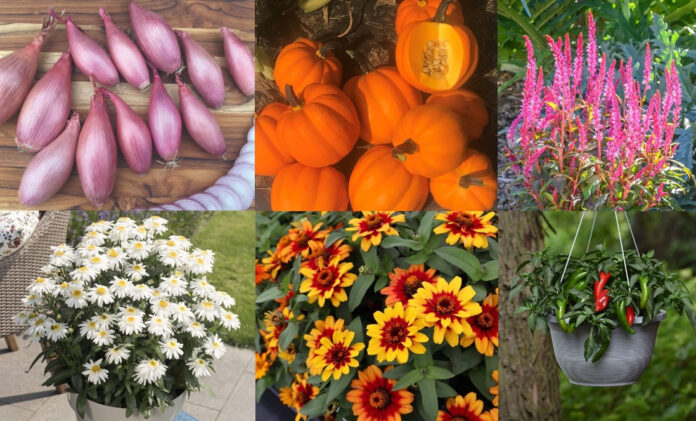
by Erl Svendsen
Since 1933, you can trust recommendations from All-America Selections (www.all-americaselections.org) to have ‘superior garden performance,’ whether they are vegetables, annuals or perennials. You may be familiar with some of their past winners as they have truly stood the test of time: ‘Detroit’ beet (1934), ‘Straight-8’ cucumber (1935) and, more recently, ‘Purple Wave’ petunia (1995). While the 2021 winning crop is smaller than in past years, they are still champions.
‘Creme Brulee’ echalion (shallot): ‘Creme Brulee’ is a large (4-5 inches / 10-13 cm), easy-to-peel, single centred bulb with the typical coppery-pink outer skin and purple interior. Like onions, echalions are easy to grow in the home garden in full sun. Best started indoors, they can be harvested 98 days from transplant. Eaten raw in salads, they have a mild onion flavour with a hint of citrus; when sautéed, the sugars caramelize and add a depth of flavour that doesn’t overpower in a variety of home-cooked dishes.
‘Goldilocks’ acorn squash: One of the issues I have with some squash is that their vines can take over the world. Not this one! It is a compact bush type, taking up only a 4-5-foot (1.2-1.5-m) circle. The other issue I have with squash is their sometimes late harvest. But with ‘Goldilocks’, harvest can start very early, at 70 days after transplant. Each bush produces up to ten 1-pound (500 g), rounded, bright orange squash. When cooked, they have a sweet, rich nutty flavour with a great texture.
Kelos ‘Candela Pink’ celosia: This tall, stunning pink annual is versatile and can be grown equally well in containers and garden beds. The hot pink, poker-like flowers are 10-15 inches (25-40 cm) long, making the total plant height 25-30 inches (65-75 cm). With no deadheading needed, it earned the nickname ‘Energizer Bunny’ for its long bloom time, from late spring to fall. In addition to adding a bright splash of colour to your garden, it makes an excellent cut or dried flower. Planted in full to part sun, it tolerates heat and, for those on an acreage, it is deer resistant. It is propagated from cuttings only and not available from seed.
‘Pot-a-peno’ F1 jalapeno pepper: A very compact jalapeno pepper, and as its name suggests, it does well in containers including hanging baskets, making it perfect for patio and balcony gardens. Despite its small size, it produces masses of 3-4-inch (7.5-10-cm) long, moderately hot green peppers. Leave the peppers a few extra weeks to mature to red, and you’ll be rewarded with some spicy sweetness. Harvest can start as early as 45-50 days after transplanting, earlier than most other varieties, to give you a head start on salsa season. Plant in full sun.
‘Profusion Red Yellow Bicolor’ zinnia, an AAS Gold Medal winner (also Fleuroselect Gold Medal winner). In the past 25 years, only five other winners have been distinguished with a Gold Medal, and three of them belong to the Profusion zinnia series: Profusion Cherry (1999), Orange (1999) and White (2001). Like its forebears, this one flowers profusely from late spring to fall, on medium green, mounded, compact plants (8-14 inches / 20-35 cm). The bold and vibrant bicoloured blooms are 2.5 inches (6 cm) across. Starting out as yellow with red centres, the flowers mature to salmon, apricot and dusty rose shades, harmonizing beautifully with the newer blooms. Performing equally well in containers and the garden, they tolerate heat, rain and wind.
‘Sweet Daisy Birdy’ Leucanthemum (Shasta daisy): Unlike the tall, lanky Shasta daisies in your grandmother’s garden, this one is compact and free flowering. Bright white, 5-inch (7.5-cm) blooms with yellow centres top 18-24-inch (45-60-cm) dark green plants. It can be grown in containers as well as in the ground, towards the mid- and back border in full sun. Indoors, it adds height and brightness to informal bouquets. As a bonus, it attracts pollinators. Heat tolerant and hardy (to zone 3), it should thrive in our prairie gardens. Deadheading will help keep the plants looking their best.
Erl gardens in Saskatoon and occasionally tweets about it @ErlSv.
This column is provided courtesy of the Saskatchewan Perennial Society (SPS; saskperennial@hotmail.com ). Check our website saskperennial.ca) or Facebook page (facebook.com/saskperennial). All Saskatchewan Perennial Society events are on hold until further notice.

